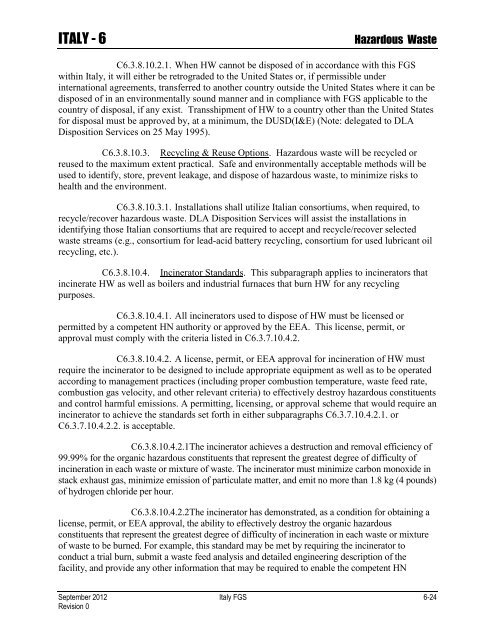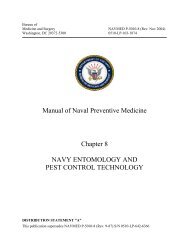ENVIRONMENTAL FINAL GOVERNING STANDARDS ITALY
ENVIRONMENTAL FINAL GOVERNING STANDARDS ITALY
ENVIRONMENTAL FINAL GOVERNING STANDARDS ITALY
Create successful ePaper yourself
Turn your PDF publications into a flip-book with our unique Google optimized e-Paper software.
<strong>ITALY</strong> - 6 Hazardous Waste<br />
C6.3.8.10.2.1. When HW cannot be disposed of in accordance with this FGS<br />
within Italy, it will either be retrograded to the United States or, if permissible under<br />
international agreements, transferred to another country outside the United States where it can be<br />
disposed of in an environmentally sound manner and in compliance with FGS applicable to the<br />
country of disposal, if any exist. Transshipment of HW to a country other than the United States<br />
for disposal must be approved by, at a minimum, the DUSD(I&E) (Note: delegated to DLA<br />
Disposition Services on 25 May 1995).<br />
C6.3.8.10.3. Recycling & Reuse Options. Hazardous waste will be recycled or<br />
reused to the maximum extent practical. Safe and environmentally acceptable methods will be<br />
used to identify, store, prevent leakage, and dispose of hazardous waste, to minimize risks to<br />
health and the environment.<br />
C6.3.8.10.3.1. Installations shall utilize Italian consortiums, when required, to<br />
recycle/recover hazardous waste. DLA Disposition Services will assist the installations in<br />
identifying those Italian consortiums that are required to accept and recycle/recover selected<br />
waste streams (e.g., consortium for lead-acid battery recycling, consortium for used lubricant oil<br />
recycling, etc.).<br />
C6.3.8.10.4. Incinerator Standards. This subparagraph applies to incinerators that<br />
incinerate HW as well as boilers and industrial furnaces that burn HW for any recycling<br />
purposes.<br />
C6.3.8.10.4.1. All incinerators used to dispose of HW must be licensed or<br />
permitted by a competent HN authority or approved by the EEA. This license, permit, or<br />
approval must comply with the criteria listed in C6.3.7.10.4.2.<br />
C6.3.8.10.4.2. A license, permit, or EEA approval for incineration of HW must<br />
require the incinerator to be designed to include appropriate equipment as well as to be operated<br />
according to management practices (including proper combustion temperature, waste feed rate,<br />
combustion gas velocity, and other relevant criteria) to effectively destroy hazardous constituents<br />
and control harmful emissions. A permitting, licensing, or approval scheme that would require an<br />
incinerator to achieve the standards set forth in either subparagraphs C6.3.7.10.4.2.1. or<br />
C6.3.7.10.4.2.2. is acceptable.<br />
C6.3.8.10.4.2.1 The incinerator achieves a destruction and removal efficiency of<br />
99.99% for the organic hazardous constituents that represent the greatest degree of difficulty of<br />
incineration in each waste or mixture of waste. The incinerator must minimize carbon monoxide in<br />
stack exhaust gas, minimize emission of particulate matter, and emit no more than 1.8 kg (4 pounds)<br />
of hydrogen chloride per hour.<br />
C6.3.8.10.4.2.2 The incinerator has demonstrated, as a condition for obtaining a<br />
license, permit, or EEA approval, the ability to effectively destroy the organic hazardous<br />
constituents that represent the greatest degree of difficulty of incineration in each waste or mixture<br />
of waste to be burned. For example, this standard may be met by requiring the incinerator to<br />
conduct a trial burn, submit a waste feed analysis and detailed engineering description of the<br />
facility, and provide any other information that may be required to enable the competent HN<br />
September 2012 Italy FGS 6-24<br />
Revision 0
















